

LYN_BOWER-Tablets_to_use_or_not_to-use-18.3.pdf. The Complete Visual Guide To Technology For Children. Digital Kindergarten: Search results for word wizard. Background This is the first year of 1:1 iPads in my kindergarten classroom.
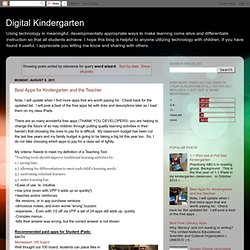
In October 2010 I received one to use with my class of 26, and by the end of May 2011 I had 11 and my class had dropped down to 22 children. I absolutely loved that half the class could be working on the iPads completely independently, at various levels, while I worked with the other half of the kids. Pinterest. 25 ways to use iPads in the classroom#Repin ... Sandbox social media for early childhood educators by fran simon. What To Know About Teachers On Pinterest. Using fun web tools like Pinterest in your classroom is not news.
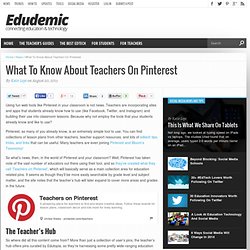
Teachers are incorporating sites and apps that students already know how to use (like Facebook, Twitter, and Instagram) and building their use into classroom lessons. Because why not employ the tools that your students already know and like to use? Pinterest, as many of you already know, is an extremely simple tool to use. You can find collections of lesson plans from other teachers, teacher support resources, and lots of edtech tips, tricks, and links that can be useful. Young children engaging with technologies at home: The influence of family context. This article is about the ways in which young children engage with technological toys and resources at home and, in particular, the ways in which the family context makes a difference to young children’s engagement with these technologies.
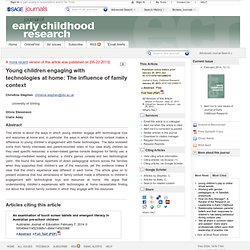
The data reviewed come from family interviews and parent-recorded video of four case study children as they used specific resources: a screen-based games console designed for family use, a technology-mediated reading scheme, a child’s games console and two technological ‘pets’. We found the same repertoire of direct pedagogical actions across the families when they supported their children’s use of the resources, yet the evidence makes it clear that the child’s experience was different in each home.
The article goes on to present evidence that four dimensions of family context made a difference to children’s engagement with technological toys and resources at home. What Does a Tablet Do to the Child’s Mind? Feng Li/Getty ImagesSpending time with devices instead of interacting with people may hinder communication skills, researchers say.
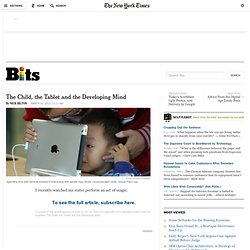
I recently watched my sister perform an act of magic. We were sitting in a restaurant, trying to have a conversation, but her children, 4-year-old Willow and 7-year-old Luca, would not stop fighting. The arguments — over a fork, or who had more water in a glass — were unrelenting. Like a magician quieting a group of children by pulling a rabbit out of a hat, my sister reached into her purse and produced two shiny Apple iPads, handing one to each child. Sponsors Now Pay for Online Articles, Not Just Ads.
Contemporary (Digital) Literacy Practices of Preps e-book (interactive) Pre K. PreK Classroom Pictures - Michele Lewis VPK - Mrs.
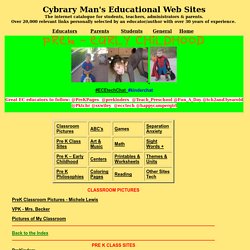
Becker Pictures of My Classroom Back to the Index. 10 Beautifully Illustrated Children’s Books Made For The iPad. Editor’s Note: This is a contributed post by Veronica Howes, Marketing Manager at Storypanda.
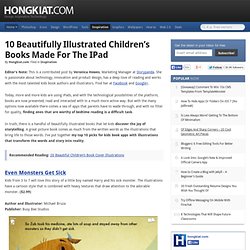
She is passionate about technology, innovation and product design, has a deep love of reading and works with the most talented kids book authors and illustrators. Find her at Facebook and Google+. Today, more and more kids are using iPads, and with the technological possibilities of the platform, books are now presented, read and interacted with in a much more active way. But with the many options now available there comes a sea of apps that parents have to wade through, and with no filter for quality, finding ones that are worthy of bedtime reading is a difficult task.
In truth, there is a handful of beautifully illustrated books that let kids discover the joy of storytelling. New Tab. Free Classroom Guides and Educational Downloads. How to Create Social Media Guidelines for Your School. Five Essentials To Create Connected Students.
Recently we had a holiday, or at least it felt like one.
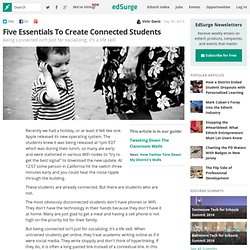
Apple released its new operating system. The students knew it was being released at 1pm EDT which was during their lunch, so many ate early and were stationed in various WiFi nodes to "try to get the best signal" to download the new update. At 12:57 some person in California hit the switch three minutes early and you could hear the noise ripple through the building. These students are already connected. Www.lse.ac.uk/media@lse/research/EUKidsOnline/EU Kids III/PDFs/Zero_to_eight.pdf.
Flipping In Kindergarten: Connecting Home and School. One question I get asked often is about flipping my Kindergarten class.
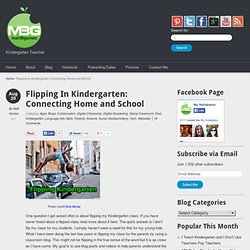
If you have never heard about a flipped class read more about it here. The quick answer is I don’t flip my class for my students. I simply haven’t seen a need for this for my young kids. What I have been doing the last few years is flipping my class for the parents by using a classroom blog. Spotlight. Twitter Hashtags for #ECETech. The image of the teacher: rich, competent, theory builder.
The image of the child in the Reggio Emilia approach is one of a rich, competent, capable theorybuilder.
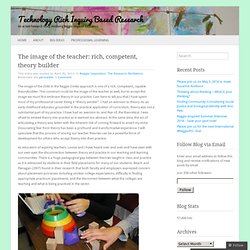
This construct could be the image of the teacher as well, but to accept this image we must first embrace theory in our practice. Creating Amazing "I Spy" Compositions To Photograph With Their iPads Today. What a fun day in the library!
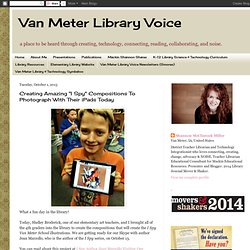
Today, Shelley Broderick, one of our elementary art teachers, and I brought all of the 4th graders into the library to create the compositions that will create the I Spy Van Meter School illustrations. We are getting ready for our Skype with author Jean Marzollo, who is the author of the I Spy series, on October 15. The students could work with 1 or 2 other students or by themselves. '1:X Computing' Aims to Tailor Digital Tools to Learning Tasks. Published Online: September 30, 2013 Published in Print: October 2, 2013, as Picking the Right Device for the Right Moment In Cindy Nguyen’s first-period psychology class at Lewisville High School in north-central Texas, digital devices are everywhere: During a recent lesson, 28 students were using 17 school-issued iPads, two student-owned tablets, seven smartphones, and one of the classroom’s five MacBook Air laptops. It’s the new face of learning in the rapidly changing Lewisville Independent School District, which is in the process of giving all 53,000 of its students access to “the right device at the right time,” part of a so-called “1:X” initiative that began last spring.
District officials are currently seeking to trademark the “1:X” name, which is also referred to as “1-to-many.” Ms. Experts say the 1:X initiative is rare, positioning this district in suburban Dallas as a potential trendsetter in the rapidly changing world of digital K-12 education. St Joseph's OSHC. Using Technology in Children’s Services. Educators see the word ‘Technology’ in the frameworks, both the Early Years Learning Framework, and the Framework for School Age Care and they panic. Feelings of inadequacy overwhelm them as they wonder “How in the world are we going to teach children all about computers when I am lucky to be able to download my emails once a week”, or they get a lump in their throat as they think about the cost of installing computers, tablets and online gaming in every room in their centres.
Before you pack it in and find a new career because you are so buckled with fear at the concept of having a Technology Curriculum in your weekly program, let me ease your fears. Engaging with technology, or as stated in the Frameworks ‘technologies’, is not that hard, costly or scary. It does not require a great degree of knowledge about computers, software programs, nor a great deal of money. All that is needed is a few ideas, some key words and a starting point! Personalized learning in kindergarten. You can’t cross the sea merely by standing and staring at the water. -Rabindranath Tagore I recently wrote about incorporating a more personalized approach to learning in my classroom here and how that meant building the plane while I fly it. I’ve always believed in student-centered classrooms and in many ways, my classroom already had many aspects of voice and choice. So perhaps I wasn’t starting the plane from scratch after all.
It can be intimidating and sometimes, downright paralyzing, to consider changing an entire classroom management system. These center boards for morning and afternoon help me begin choice in kindergarten. ABC center. Students Lead the Way, Following Kindergarten’s Digital Engineers into the Classroom. 1.28.11 | Interest-driven learning; predictions for even more contributions from student programmers; the Games, Learning and Society Conference 2011 calls for papers; Latin American teens write novels online; a bittersweet parting at Global Kids and more. The iTot Challenge: Michael Levine, executive director of the Joan Ganz Cooney Center, makes the case for investing in research on how digital media is changing learning for preschool and school-age kids.
Writing at the Huffington Post, Levine says parents of kids under age 6 are engaged in what experts call the “‘pass-back’ effect—those precious moments of relief when a parent hands their digital device to a child on a car ride, standing in the check-out line, or at the doctor’s office.” Learning with technology for pre-service early childhood teachers (Free full-text available) Anne Campbell Faculty of Education, University of Canberra Grazia Scotellaro Faculty of Education, University of Canberra This paper describes an innovative pilot project at the University of Canberra aimed at providing pre-service early childhood teachers with the skills, confidence and ideological change required to include technology-enhanced learning as part of the early childhood curriculum.
The impact of the project was evaluated through participant observation, and a thematic analysis of entries in student learning diaries, student feedback and transcriptions of semi-structured interviews with staff involved in the delivery of the program. Introduction. ECEtech.net. Digital Literacy Skills Self Assessment (EC) Technology and interactive media as tools in EC programs.
How to evaluate apps/software/websites. Daniel Donahoo: Shifting the Conversation on Early Childhood and Technology. Technology. iPads for education. About the iPad initiative Nineteen primary schools have been selected to participate in the Early Childhood iPad Initiative. The selection criteria considered the greatest level of improvement in NAPLAN reading and numeracy for results between 2009 and 2011.
The Role of Technology in EC programs. Moglue - Create. Play. Share. TEC Center: Technology in Early Childhood. Virtual Learning for Little Ones Raises Developmental Questions. Technology and Young Children. Key Messages. GoToWebinar : Webinars Made Easy. Award-Winning Web Casting & Online Seminar Hosting Software. Not all appy children get best of educations.
Stimulating creativity: KU Killara Park preschoolers use educational apps on the school's iPads. Photo: Ben Rushton In the expanding world of early childhood education and technology, not all apps are created equal. Several Australian studies into preschoolers and tablet computers are under way and have found the devices can be an effective learning tool if used appropriately. Does technology hinder or help toddlers' learning? 19 April 2013Last updated at 17:38 ET By Philippa Roxby Health reporter, BBC News. Pros and Cons of the iPad in Education — Apple News, Tips and Reviews. The ripple effect. ICT in Early Childhood Education - TED Talks.
TED Talk: Media Exposure and Early Childhood. 2013. Seven myths about young children and technology. ICT in Early Childhood Education: TED Talk - J. Harris: The Web's secret stories. Thomas Suarez: A 12-year-old app developer. Digital Vs Paper Documentation. Technology help with 3-5 year olds. Digital natives come to preschool: Rethinking practice. Opportunities to explore technology.